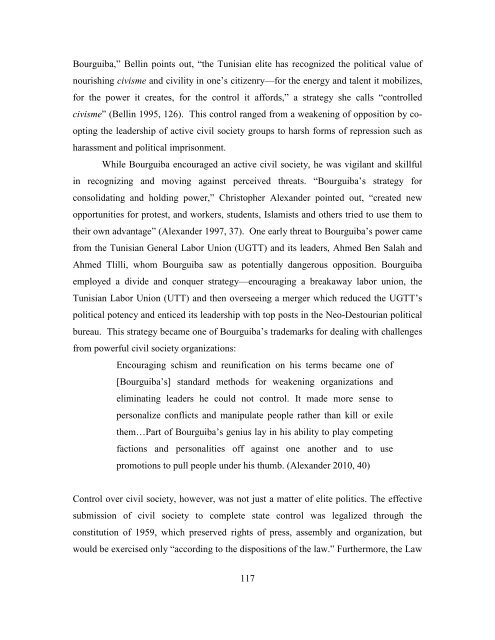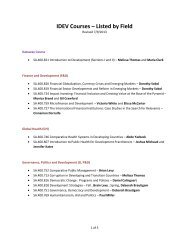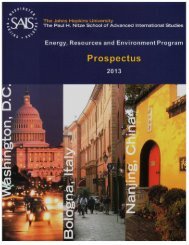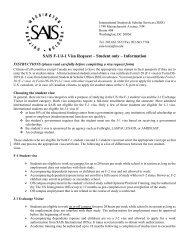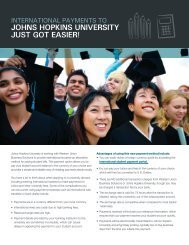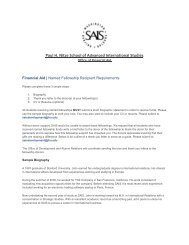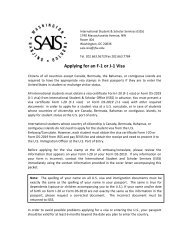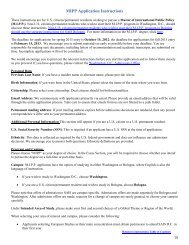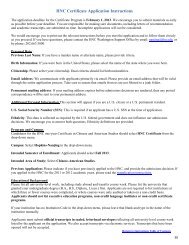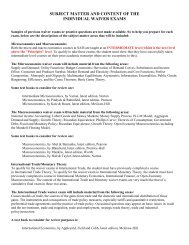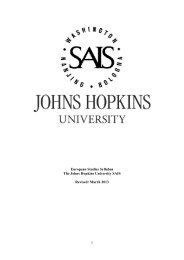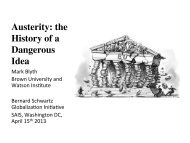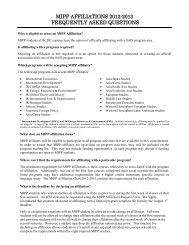Tunisia: Understanding Conflict 2012 - Johns Hopkins School of ...
Tunisia: Understanding Conflict 2012 - Johns Hopkins School of ...
Tunisia: Understanding Conflict 2012 - Johns Hopkins School of ...
You also want an ePaper? Increase the reach of your titles
YUMPU automatically turns print PDFs into web optimized ePapers that Google loves.
Bourguiba,” Bellin points out, “the <strong>Tunisia</strong>n elite has recognized the political value <strong>of</strong><br />
nourishing civisme and civility in one’s citizenry—for the energy and talent it mobilizes,<br />
for the power it creates, for the control it affords,” a strategy she calls “controlled<br />
civisme” (Bellin 1995, 126). This control ranged from a weakening <strong>of</strong> opposition by coopting<br />
the leadership <strong>of</strong> active civil society groups to harsh forms <strong>of</strong> repression such as<br />
harassment and political imprisonment.<br />
While Bourguiba encouraged an active civil society, he was vigilant and skillful<br />
in recognizing and moving against perceived threats. “Bourguiba’s strategy for<br />
consolidating and holding power,” Christopher Alexander pointed out, “created new<br />
opportunities for protest, and workers, students, Islamists and others tried to use them to<br />
their own advantage” (Alexander 1997, 37). One early threat to Bourguiba’s power came<br />
from the <strong>Tunisia</strong>n General Labor Union (UGTT) and its leaders, Ahmed Ben Salah and<br />
Ahmed Tlilli, whom Bourguiba saw as potentially dangerous opposition. Bourguiba<br />
employed a divide and conquer strategy—encouraging a breakaway labor union, the<br />
<strong>Tunisia</strong>n Labor Union (UTT) and then overseeing a merger which reduced the UGTT’s<br />
political potency and enticed its leadership with top posts in the Neo-Destourian political<br />
bureau. This strategy became one <strong>of</strong> Bourguiba’s trademarks for dealing with challenges<br />
from powerful civil society organizations:<br />
Encouraging schism and reunification on his terms became one <strong>of</strong><br />
[Bourguiba’s] standard methods for weakening organizations and<br />
eliminating leaders he could not control. It made more sense to<br />
personalize conflicts and manipulate people rather than kill or exile<br />
them…Part <strong>of</strong> Bourguiba’s genius lay in his ability to play competing<br />
factions and personalities <strong>of</strong>f against one another and to use<br />
promotions to pull people under his thumb. (Alexander 2010, 40)<br />
Control over civil society, however, was not just a matter <strong>of</strong> elite politics. The effective<br />
submission <strong>of</strong> civil society to complete state control was legalized through the<br />
constitution <strong>of</strong> 1959, which preserved rights <strong>of</strong> press, assembly and organization, but<br />
would be exercised only “according to the dispositions <strong>of</strong> the law.” Furthermore, the Law<br />
117


